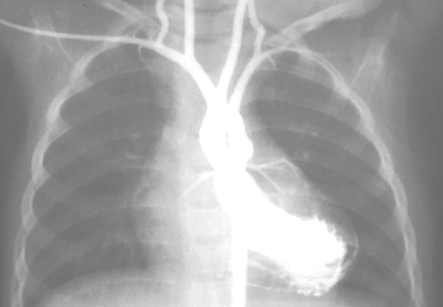Angiocardiography
Introduction
Angiocardiography is examination of the blood vessels or chambers of the heart. It is performed by tracingthe course of a contrast dye or radionuclide which is injected into the bloodstream. Tracing is done either by X-ray or radiological techniques. These pictures are called as angiograms. The structures most commonly evaluated by this technique are left ventricle, heart valves, coronary arteries, aorta, and pulmonary arteries.
In traditional angiocardiography, a contrast material or dye is injected into the heart through catheterization of femoral vessel. The contrast material is radio-opaque and absorbs x-rays differently than the surrounding blood vessels and soft tissues, allowing clear visualization of various structures of the body. Once the contrast material is injected, large x-ray films are exposed in two planes at right angles to each other. This permits the simultaneous recording of two different views (bi-plane angiocardiography). In cine-angiocardiography, the x-ray images are brightened several thousand times and photographed as motion picture films. When projected, the passage of the contrast containing blood may be viewed in slow motion. Cine-angiocardiography has now been replaced by digital capture of the pictures. This digital capture allows real-time display of cardiac structures and permits the information to be stored on a CD-ROM. This information can be uploaded on internet or transferred to a computer.
Iran is among the top 10 countries in treating cardiovascular diseases, while it ranks first in the Middle East

Radionuclide angiocardiography uses red blood cells which are tagged with a low-level radioactive substance so that their path through the circulatory system can be tracked easily.
There are several variations of radionuclide angiocardiography, which include:
1. First-pass radionuclide angiocardiography – this method examines only one pass of the substance through the heart
2. Equilibrium radionuclide angiocardiography or gated equilibrium radionuclide angiocardiography – this follows passage of the radionuclide through hundreds of circulatory cycles and looks at specific phases of heart function.
Angiocardiography technique is used to evaluate the patients for surgery on the heart and its associated major blood vessels. Various techniques measure the volume of blood pumped, the effectiveness of heart contractions, the patency of heart valves, and the condition of the coronary and pulmonary (lung) arteries. It can also show abnormal connections or shunts between blood vessels as well as between heart chambers. Various procedures such as angioplasty, coronary stenting, and valvuloplasty may be performed during angiocardiography. Although angiocardiography is a valuable investigation for assessing some of the more complicated aspects of heart function, it is also one of the more hazardous diagnostic procedures. This technique is classified as an invasive procedure. Therefore, it must be performed in a hospital setting under strict controls. Recent advances in echocardiography, which are not invasive and do not use radioactive material, are now replacing the traditional angiocardiographic evaluations for some individuals.
The procedure is performed by inserting a long narrow tube or cardiac catheter into a blood vessel, usually in the groin or arm.
These techniques include radionuclide ventriculography, gated single photon emission tomography (PET), and magnetic resonance imaging (MRI). MRI is the most accurate available non-invasive imaging study for determination of left ventricular ejection fraction. The results of MRI are onlycomparable to 3D-echocardiography. The gold standard is, however, still angiocardiography. This method may reveal localized areas of diminished wall motion, absent, or opposite in direction from normal motion. Wall motion analysis is especially useful in the evaluation of coronary artery disease. Areas of insufficient blood supply or tissue death in the heart can be identified even when overall heart performance is normal. Angiography can provide more accurate information about ventricular function. The arteries and veins of the lungs can be examined by injecting a contrast medium into the pulmonary artery. The main purpose of pulmonary angiocardiography is to confirm a diagnosis of a suspected pulmonary plug. This plug can be composed of a detached blood clot (thrombus) or other foreign body (embolus). Pulmonary angiocardiography is an investigation which is ordered when other non-invasive test results are uncertain. This test is also useful when detailed anatomical information is needed to plan for surgical removal of a pulmonary embolus. Other pulmonary vascular disorders can also be diagnosed with this procedure.
Angiocardiography is an invasive procedure done under anesthesia. The actual procedure takes only about 1 hour, but preparation and recovery both require at least a day each. Some individuals may need to remain in the hospital overnight.
The procedure is performed by inserting a long narrow tube or cardiac catheter into a blood vessel, usually in the groin or arm. This small tube is then advanced toward the heart. The catheter is placed into a vein to visualize the right side of the heart and into an artery to examine the aorta, coronary arteries, and left side of the heart. After the catheter tip has been guided into the heart chamber or vessel to be studied, contrast medium is injected through the catheter. This contrast medium mixes with the blood and moves through the circulation. The movement of the contrast is observed and the images are recorded.